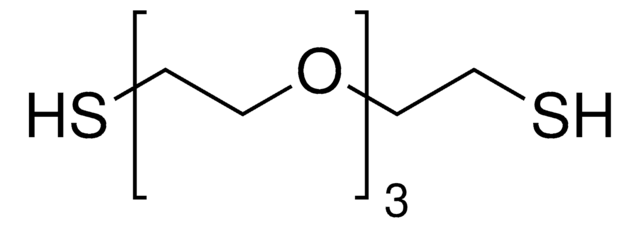Wichtige Dokumente
673110
Triethylenglykolmono-11-Mercaptoundecylether
95%
Synonym(e):
(11-Mercaptoundecyl)-tri-(ethylenglykol)
About This Item
Empfohlene Produkte
Qualitätsniveau
Assay
95%
Brechungsindex
n20/D 1.476
Dichte
0.995 g/mL at 25 °C
Lagertemp.
−20°C
SMILES String
OCCOCCOCCOCCCCCCCCCCCS
InChI
1S/C17H36O4S/c18-10-12-20-14-16-21-15-13-19-11-8-6-4-2-1-3-5-7-9-17-22/h18,22H,1-17H2
InChIKey
FASSFROSROBIBE-UHFFFAOYSA-N
Verwandte Kategorien
Allgemeine Beschreibung
Anwendung
Lagerklassenschlüssel
10 - Combustible liquids
WGK
WGK 3
Flammpunkt (°F)
>230.0 °F
Flammpunkt (°C)
> 110 °C
Persönliche Schutzausrüstung
Eyeshields, Gloves
Hier finden Sie alle aktuellen Versionen:
Besitzen Sie dieses Produkt bereits?
In der Dokumentenbibliothek finden Sie die Dokumentation zu den Produkten, die Sie kürzlich erworben haben.
Kunden haben sich ebenfalls angesehen
Artikel
Inorganic nanomaterials are tunable by size, shape, structure, and/or composition. Advances in the synthesis of well-defined nanomaterials have enabled control over their unique optical, electronic, and chemical properties stimulating tremendous interest across a wide range of disciplines. This article illuminates some of the recent research advances of inorganic nanoparticles (NPs) in optoelectronics applications.
Self-assembled monolayers (SAMs) have attracted enormous interest for a wide variety of applications in micro- and nano-technology. In this article, we compare the benefits of three different classes of SAM systems (alkylthiolates on gold.
Unser Team von Wissenschaftlern verfügt über Erfahrung in allen Forschungsbereichen einschließlich Life Science, Materialwissenschaften, chemischer Synthese, Chromatographie, Analytik und vielen mehr..
Setzen Sie sich mit dem technischen Dienst in Verbindung.![2-{2-[2-(2-Mercaptoethoxy)ethoxy]ethoxy}ethanol 97%](/deepweb/assets/sigmaaldrich/product/structures/130/969/7d2ec2b4-e0f1-4836-aeb2-139994173612/640/7d2ec2b4-e0f1-4836-aeb2-139994173612.png)












